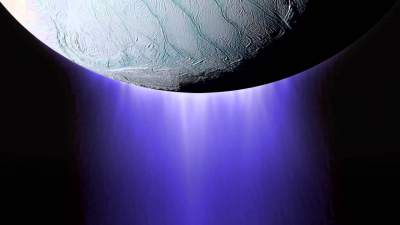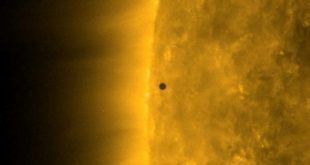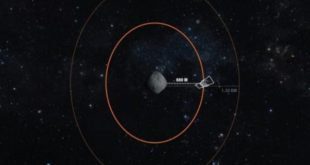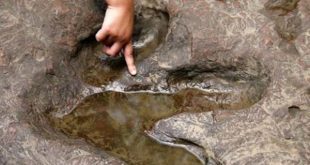 At the South pole of the small icy moon of Saturn Enceladus has been committed the most sensational discovery of all.
At the South pole of the small icy moon of Saturn Enceladus has been committed the most sensational discovery of all.
Speaking at Harvard in 2011, Carolyn Porco, head of the scientific visualization team Cassini, announced that the South pole of the small icy moon of Saturn Enceladus has been committed the most sensational discovery of all. In the polar region of the satellite revealed elevated temperatures, as well as a huge plume of icy particles shooting tens of thousands of kilometers into space.
Analysis of the icy trail, which includes water vapor and trace quantities of organic materials such as methane, carbon dioxide and propane, suggests it is fueled by geysers erupting from a global ocean buried beneath the icy surface of the satellite.
These findings, according to Porco, indicate the possibility of the existence of “environment, in which can dwell a life. If we discover a second Genesis in our Solar system independent of Earth, it will be breaking all the rules. The existence theorem has been proven, and we could safely conclude that life is not a bug, but a feature of the Universe in which we live, and that is a very banal event, which occurred a staggering number of times”.
Most recently, Edwin Kite, associate Professor of geophysical Sciences at the University of Chicago, called Enceladus “opportunity to conduct the best experiment of astrobiology in the Solar system”. He added that Enceladus is a leading candidate for extraterrestrial life. Cassini data powerfully indicate that kriovulkanizma plumes of Enceladus may come from oceanic environments, friendly to biomolecules.
The safety of massive explosive cracks on the surface of the sixth-largest moon of Saturn, despite the surprisingly cold surface of the moon, remained a mystery for 11 years. Not so long ago, however, scientists from Princeton University and the University of Chicago showed that cracks can be active under the action of sloshing water in the vast ocean, which suggests that the moon is under a thick icy crust. These findings lay a strong Foundation for future missions on satellites Enceladus, which primarily will be engaged in the search for life.
The so-called “tiger stripes, the cracks on Enceladus, regularly throw out high jets of steam and frozen particles, fueled by tidal forces caused by Saturn, the scientists write in proceedings of the National Academy of Sciences. Four tiger stripes are located near the South pole of Enceladus an average of 130 kilometers in length and are spaced from each other at 35 kilometers. The first time they watched the unmanned spacecraft NASA Cassini in 2005, which orbits around Saturn and its moons since 2004. Cassini data indicate that the emissions of the moon, may have occurred in the biologically friendly ocean.
Since the observations by Cassini of the fractures and emissions, scientists are trying to explain their cause, size, and consistency, says Edwin Kite.
“On Earth the eruption usually don’t last too long,” says Kite. — When you see too long eruption, it is due to several eruptions with large spaces between them. It is difficult to explain why the system is cracking your own is not clogged with ice. And it is difficult to explain why the energy output from the groundwater does not freeze absolutely everything.”
Kite and his co-author Alan Rubin, a Princeton Professor of Geosciences, has developed a model that assumes that water in the grooves alternately raised and lowered in the grooves, which bend under the action of tidal stresses in the ice shell of Enceladus. Heat that produces this regular movement enough to keep the water from freezing, even if the moon lies under the ice of 30-km thickness.
The model of the Kite, and ruby gives a seemingly simple explanation for the observations that challenged this simple explanation in the past. Previous proposals, for example, that tiger stripes is slack in the ice melt by frictional heating cannot explain the fact that the spewing material comes from an underground ocean of Enceladus. Kite turned to Rubin because Rubin was in the past engaged in the transport of molten rock through fissures in the Earth. But when the Kite is speculated that the viscous movement can save the water in the grooves from freezing, Rubin initially reacted to this idea with skepticism.
“Because the viscosity of water is so small, I doubt that it will produce enough heat,” says Rubin, ” but the calculations of the Kite testified that she would not only produce enough heat, but does so in the time between peak tidal stresses and peak activity of eruptions. As for me, this is the first model that naturally explains the observations”.
The same model can be applied to other icy worlds like Jupiter’s moon Europe, which also has a subsurface ocean and is often referred to as a planetary body, is able to have a life. “Enceladus could be added to that list. Direct path to the subsurface oceans on these moons may be possible in a Windows environment that contains life”.
If we assume that tiger stripes are really connected with the ocean of Enceladus, and future satellite missions can be equipped with sensors and equipment to search for possible evidence of life on the moon, says Rubin. Recent flyby Cassini around Enceladus was held on 19 Dec.
Tiger stripes of Enceladus regularly spew high jets of steam and frozen particles
Carolyn Porco said that the work of the Kite, and ruby can explain a number of issues about the cracks satellite.
For example, the plumes of the eruptions reach its peak about five hours later than expected even if you take into account the 40 minutes that needed spewing particles to reach the height at which the “Cassini” recorded it. Previously, scientists have already given possible explanations for this delay, including slow reacting icy shell.
Kite and Rubin found that there is an optimal width of grooves tiger stripes, which explains the timing of eruptions. Width of grooves affects how quickly they respond to tidal forces. In the case of a wide groove, the eruption quickly respond to tidal forces, says Kite. With narrower grooves, eruptions occur after eight hours after tidal forces reach their peak. “There’s a bull’s-eye,” he says, in which tidal forces turn water movement into heat, generating enough energy to produce the eruption, guests observed a five-hour delay. Porco believes this is the best moment in the study.
The plans of the Kite — the study of analogues of Enceladus geysers on Earth, the nearest examples of which can be found in Antarctica.








